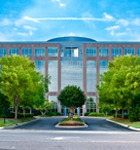Following a two year process of building optimization and data collection, Spectrum Properties|Emery, a commercial-real-estate company, achieved LEED certification of 1.4 million square feet of multitenant office space in Franklin, Tennessee. The six-building, 900,000-square-foot Corporate Centre campus earned LEED-EB Gold certification, the first multitenant campus in the state to do so, and the 500,000-square-foot Carothers Building earned Silver. This was a milestone for commercial real estate, representing the largest collection of multitenant LEED-level office buildings in Tennessee and one of the largest in the country. Here’s a look at Spectrum’s various goals for the project and how it achieved them.
1/ Design
“We wanted to set the standard for the state,” Spectrum president Pat Emery says. “Most of our tenants are Fortune 500 companies, and a lot of them want to know their facilities are sustainable. Tenants and owners migrate to that.” Luckily, the Corporate Centre campus and the Carothers Building were initially built to be energy efficient, which eased the process of achieving LEED-EB certification. “It wasn’t like taking a 30-year-old building and turning it into LEED,” Emery says. “It was taking a 15-year-old building that was already built to good design [and implementing sustainable additions].”

Three Corporate Centre represents just a portion of the LEED-certified multitenant office space Spectrum Properties oversees in Franklin, TN. Photo: Bob Schatz.
2/ Certification
“The hardest task was the fact that we’re multitenant, not owner-occupied like a lot of buildings that go through LEED,” says Brooke Nicholson, a LEED-accredited project manager and property manager for Spectrum. “Our first priority is to keep the tenants happy.” The process of certifying the buildings involved a variety of diverse projects, including commissioning the buildings systems, performing waste-stream audits, and conducting thermo-imaging scans to show heat loss through the envelopes of the buildings. Spectrum also hired SSRCx, a green consulting firm, to assist with the process. “They’ve been through the process before and told us what we could fix without a lot of cost upfront,” Nicholson says. “We didn’t want to go through this process and purchase points.”
3/ Operations
SSRCx worked closely with Spectrum and its vendors to update a number of operational policies and procedures used on the campuses. This involved inspecting the equipment and chemicals used by vendors and ensuring they were the most sustainable options available. “We worked with the site and landscape vendors to ensure they weren’t overfertilizing or spreading pest-management chemicals,” SSRCx project manager Tabitha Goodman says, adding that the amount of water used for landscaping was reduced by using moisture-sensing irrigation systems.
Chemicals for cleaning the exterior of the building were updated to biodegradable ones in order to meet the criteria of third-party organizations such as Green Seal, and interior cleaning was improved via a green cleaning program that includes the use of microfiber rags rather than paper towels. The rags are laundered on-site and reused. “We worked collaboratively to fine tune what most vendors were already doing,” Goodman says.
4/ Finishing Touches
Outside each building, light fixtures not focused directly downward were retrofitted with dimmer 45-watt bulbs to reduce nighttime light pollution. Indoors, motion sensors were installed in restrooms and closets to improve energy efficiency. Also, according to Nicholson, Spectrum optimized each building’s HVAC start and stop times to correspond with standard work hours, and the firm installed a white roof on the Carothers Building to achieve further energy savings by reducing solar-heat gain.
As a final measure, each building’s water and plumbing fixtures—everything from urinals and faucets—were adjusted to be low-flow. The interior plumbing retrofits are estimated to save more than two million gallons of water each year when compared with the plumbing in buildings of similar age and size.
Such retrofitting has helped Spectrum position itself well for the future. “We now have the documentation and the track record of doing [the LEED process], so we can do it for others,” Emery says. “This is a good starting point rather than an ending point.”

